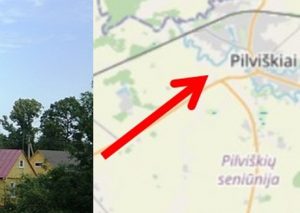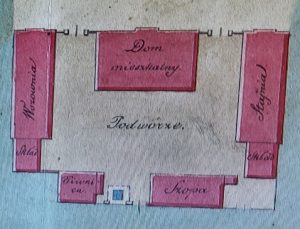
Pilviškiai 1798
When the small and still very young town of Pilviškiai came under Prussian administration in 1795 during the Third Partition of Poland-Lithuania, a census of the Jewish inhabitants was arranged. It took place in 1798.

When the small and still very young town of Pilviškiai came under Prussian administration in 1795 during the Third Partition of Poland-Lithuania, a census of the Jewish inhabitants was arranged. It took place in 1798.

Rabbi Moses Nadel was buried in Koenigsberg. We can give face and history to his name: Nadel was born ab. 1882 in Viešintos (Lithuania), was ordinated by the Vilna Beit Din and served as a shochet and mohel in Krekenava.

Found object: Beautiful drawing of the new post office in 1847 on the road to Königsberg

Šakiai: The work on the list is still going on. But already now it can be revealed that there were many grain merchants in the town, but also several glaziers and even a bookbinder.

The town had almost an urban appearance because of the customs revenues and the lively trade with its hotels, inns and stores. The Memel River was the important transport and trade artery for timber and flax imports from the interior of the continent to the Baltic Sea (via the ports of Memel or Königsberg)

This is therefore the first attempt to present the Jewish history of Mémel in words and pictures. It is obvious that the Litvaks, the Jews from Lithuania, were an integral part of the Memel community throughout the period. This publication is intended for all who are interested in Jewish history. The author hopes that it will help fill in the gaps in the history of the city of Klaipėda, the region and the Jewish minority.

We are sad to have just heard about Hanoch (Heiny) Ellert’s passing.
He has reported about the fate of Jews from Heydekrug and Žemaičių Naumiestis in a video.

However, all over the world, there are Jewish families who connect their roots with today’s Klaipeda. They managed to flee Europe at the end of the 1930s. In their language, they also took with them memories of their old hometown. (….)

For a long time the fate of the abandoned synagogue building in the middle of the town was uncertain, but in 2014 the building was declared a historical monument and we were glad to see the building secured against further decay during a visit in October 2020.

Silute/Heidekrug 16 Oct. 2020: At a seminar in Silute, Ruth Leiserowitz presents pictures from the photo album of Rita Lax. The audience could contribute many